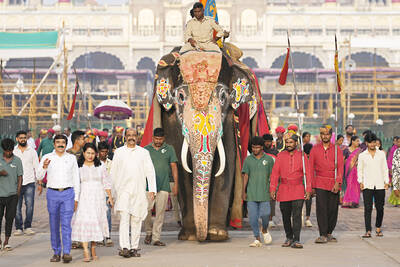Hot on the heels of last week’s fun water prank, this week’s experiment doubles as a nifty party trick. Today you’ll learn how to put a banana into a bottle without touching either of them. As usual it’s not all fun and games — there’s plenty of science involved. Warning: Do not attempt this experiment if you do not have permission to use boiling water.
緊接著上週的趣味水瓶惡作劇後,本週的實驗將晉升為俏皮的派對把戲。今天你將學會如何在不碰到香蕉和水瓶的狀況下,把一根香蕉放進水瓶裡。正如往常一樣,這個實驗不僅是好玩的把戲,也包括了很多科學知識。警告:這個實驗會用到沸騰的開水,你必須得到大人的許可才能進行這項實驗。
What you will need: an empty glass bottle, a dishcloth, a funnel, a kettle and a banana.
實驗所需:一個空的玻璃瓶、一塊抹布、一個漏斗、一個水壺和一根香蕉。
METHOD-OLOGY
Step 1: Put the funnel into the bottle and half-fill it with boiling water from the kettle. Take out the funnel and then wrap a dishcloth around the bottle. Swirl the water around the bottle until the entire bottle is hot.
Step 2: Peel the banana and eat half of it. Quickly pour the water out of the bottle and put the pointed end of the banana in the neck of the bottle. Don’t force it in too hard — just make sure it forms an airtight seal.
Step 3: After a couple of seconds the banana will get sucked into the bottle. If the experiment doesn’t work the first time, adjust the variables (bottle size, banana size and water temperature) until it works.
方法
步驟一:把漏斗放在玻璃瓶上,然後倒入水壺中的滾水至半滿。移開漏斗,用抹布包住瓶子。搖晃瓶身使熱水來回打轉,直到整個瓶子都變熱為止。
步驟二:剝開香蕉,吃掉半根。迅速倒掉玻璃瓶中的熱水,然後把剩下那半根香蕉的尖頭端放在瓶頸。不需要用力把香蕉塞進去,只要確認香蕉有密封住瓶子就行。
步驟三:幾秒鐘後,這半根香蕉就會被吸進瓶中。如果第一次實驗沒有成功,調整變因(玻璃瓶尺寸、香蕉大小和水溫)後再測試看看,直到成功為止
WHY IT WORKS
實驗原理
As you might have guessed, air pressure is key to this experiment. By adding hot water to the bottle you heat the glass. When the water is removed, the air inside the bottle is heated up. The hot air expands and some of it leaves the bottle.
When you put the banana in the neck, the air inside the bottle cools down, lowering the air pressure. Because the air pressure in the room is higher than the pressure in the bottle, the banana is pushed into the bottle.
你可能已經猜到了,這個實驗的關鍵因素是氣壓。你加入瓶中的熱水使瓶子受熱,當你倒掉熱水時,瓶中的空氣已經被加熱。熱空氣會膨脹,所以有一些空氣會逸出瓶外。
當你將香蕉放在瓶頸時,瓶中的空氣冷卻,氣壓也跟著降低。因為室內的氣壓高過瓶中的氣壓,所以香蕉就被推進瓶子裡了。
REAL LIFE APPLICATION
生活中的應用
Air pressure is fundamental to human survival. When you breathe, your lung capacity expands, and air pressure forces air into your lungs. Without air pressure, the respiratory system would cease to function.
氣壓對人類的生存來說非常重要。當你呼吸時,你的肺容量增加,氣壓會使空氣進入肺中。若少了氣壓,我們的呼吸系統就會停止作用。
(翻譯:袁星塵)

A jumbo operation is moving 20 elephants across the breadth of India to the mammoth private zoo set up by the son of Asia’s richest man, adjoining a sprawling oil refinery. The elephants have been “freed from the exploitative logging industry,” according to the Vantara Animal Rescue Centre, run by Anant Ambani, son of the billionaire head of Reliance Industries Mukesh Ambani, a close ally of Prime Minister Narendra Modi. The sheer scale of the self-declared “world’s biggest wild animal rescue center” has raised eyebrows — including more than 50 bears, 160 tigers, 200 lions, 250 leopards and 900 crocodiles, according to

They were four years old, 15 or only seven months when they were sent to Auschwitz-Birkenau, Bergen-Belsen, Buchenwald and Ravensbruck. Some were born there. Somehow they survived, began their lives again and had children, grandchildren and even great grandchildren themselves. Now in the evening of their lives, some 40 survivors of the Nazi camps tell their story as the world marks the 80th anniversary of the liberation of Auschwitz-Birkenau, the most notorious of the death camps. In 15 countries, from Israel to Poland, Russia to Argentina, Canada to South Africa, they spoke of victory over absolute evil. Some spoke publicly for the first